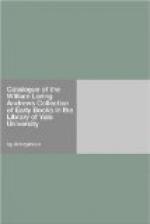This Ms. of the first Decade of Livy is in unusually fine preservation, and is bound in russia extra, with broad borders of gold and gilt marbled edges.
Brought from Palermo by Dr. Anthony Askew (1722-1772), it was sold with his collection of MSS. in 1785. Michael Wodhull, Esq., of Thenford, Northamptonshire, who gave seven guineas for the volume at “White’s sale” in March, 1798, added to his customary entry of these details on the fly-leaf this note: “This appears to be the very Book which I saw Sir W. Burrell purchase at Dr. Askew’s manuscript Auction (No. 482) for thirty-two guineas; in Sir W. Burrell’s Auction, May, 1796, it is said to have gone for about five (No. 657). The note in Bib. Askev. manuscripta is: ’Ex Panormo in Sicilia hunc cod. adduxit secum Cl. Askevius.’ & ‘300 annor. MSS. longe pulcherrimus.’”
At the sale of the Wodhull library in January, 1886, the Livy Ms. and the greater part of the 15th-century books hereinafter described were acquired by the donor of the collection, William Loring Andrews, M.A., of New York City.
PRINTED BOOKS
1. Biblia latina. Moguntiae, Johannes Fust
et Petrus Schoeffer, 14
August, 1462.
[Folio. 481 leaves, 2 columns, 48 lines to the column, gothic letter, without signatures, catchwords or pagination.]
Leaves 204, 205 containing Judith xiv. 17—Esther iv. 4.
Fol. 204^b, col. 1 (red): expl_icit_ liber iudith secundu_m_ ieronimu_m_. Incipit p_r_ologus in libru_m_ hester. Col. 2 (red): Explicit p_r_olog_us_. Incip. liber hester. Hain 3050. Pellechet 2281. Copinger 4. Brit. Mus. 15th cent., I, p. 22. Burger pl. 74. De Ricci 79.
Five-line initial of prologue and fourteen-line initial I of Esther i. 1 supplied in colors. Heading of leaf in alternate red and blue capitals. Initial-strokes in red on text capitals. Measurement 16-1/4 x 11-1/2 in.
The fourth printed Bible, and the first in which place, printers’ names and date are given. These details, which are wanting in so many of the books of the early printers, Fust and Schoeffer—and Schoeffer when he carried on the business alone—rarely failed to add to anything large enough to be called a book that came from their press. This is their fifth book and the colophon attached to the first, the famous Psalter of 1457, was repeated in them all, with no essential change beyond the date, and continued to do duty for ten years longer. In the present Bible among the typographical differences found in the copies are three varieties of the colophon, two of which however are identical in language and differ only in the printers’ use of contractions and capitals. The more common of the forms affirms that: “This present work by the ingenious invention of printing or stamping letters without any scratching of the pen has been thus fashioned in the city of Mainz and to the worship of God has been diligently brought to completion by Johann Fust citizen and Peter Schoeffer clerk of the same diocese in the year of the Lord 1462, on the eve of the Assumption of the Virgin Mary.”




